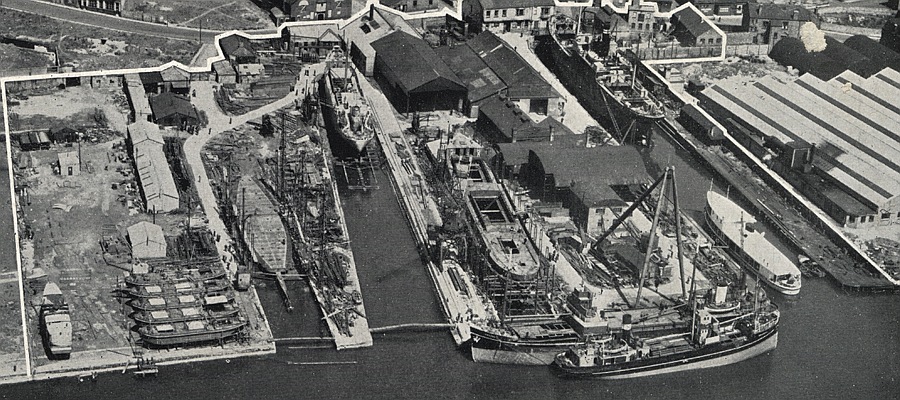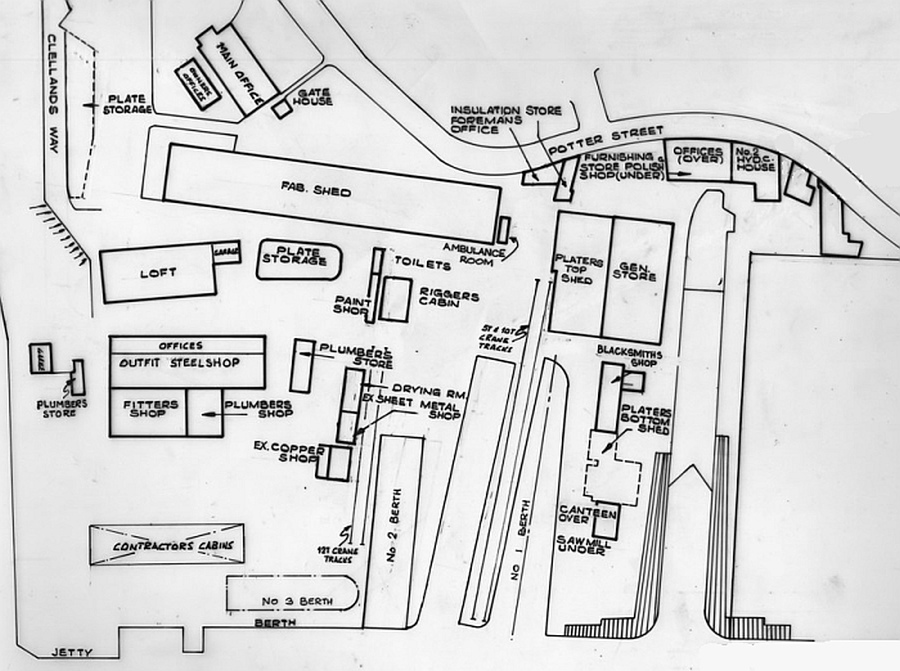Clelands of Willington Quay on Tyne 1866 to 1983/84
This small yard on the north bank of the river was, until the last 40 years or so of its existance, basically a shiprepair business with occassional shipbuilding contracts.
In the early shipbuilding days the output was mainly fishing vessels and tugs, which in those days were very similar types of vessels.
In the 1940s after the war Clelands got a big order from Burmah Oil Co for river barges and towing vessels.
Another big order, this time for India, was for deep-sea barges.
All these craft were built to be broken down into two sections then loaded on to the deck of cargo ships, transported then re-assembled at their destination.
The cargo ships that were built were predominently of the small collier type usually motorships with machinery aft.
Clelands was a very adaptable company and built craft of all shapes and sizes, with the oil companies being the most fequent customers.
This was in pre-North Sea oil days and there were twin-screw landing craft used for oil exploration and also drilling rigs with jack-up legs.
The range of vessels went from luxury yachts to pontoons, one of the latter designed for use as a bombing target.
In more recent times fishing vessels were built plus some specialist craft for the Ministry of Defence.
The shiprepair side of the business finished when the company was taken over by the Swan Hunter Group in 1967.
And then shipbuilding ceased as well in 1983. On the 25th of January 1984 British Shipbuilders announced the yard was to close, bringing an end to shipbuilding and shiprepairing since 1835.
The early days
Clelands shipyard was founded by a Scot, William Cleland (1822-1876) who had previous experience with T & W Smith and also been Yard Manager of Palmers' Howdon Yard on an adjoining site.
Cleland’s site had been a building yard since at least 1835, when Thompson Smith started there, succeeded by brother Charles, then Thomas Brown and then the Adamsons until 1866.
Cleland started up in 1867, as a repair slipway and the firm became William Cleland & Company in July 1872.
William died in 1876, aged 54, leaving two sons, Thomas (27) and Mlliam (20) and a brother James (47) an iron shipbuilder, who between them may have carried on the family connection in the firm.
An 1867 a Newcastle Journal advert describes the company as being a Shipbuilder, with Patent Slipway, Gridirons and Sawmills, capable of repairing Iron and Wood ships.
The Slipway claimed to be the best in the North of England, some 600ft long and capable of taking ships up to 1000 tons.
On the map below the Clelands site is called Willington Slipway and is between the Tharsis Copper Works and the Tyne Iron Shipbuilding yard.
The map is a section from the Ordnance Survey map for 1897

In 1890 the firm was renamed Clelands Graving Dock & Slipway Company Ltd, but there is no evidence that they ever built a graving dock, to go with the title.
From 1894 they built some small steel vessels, but after 1900 they concentrated on repair work.
In 1932 they had reached the end of the road, financially, and were offered for sale.
In 1932 the yard was purchased for £3,250 by the Craggs family from Goole.
Craggs were the owners of a similar yard, Goole Shipbuilding & Repairing Co Ltd and they named their new company Clelands (Successors) Ltd.
The yard at Willington Quay, which by this time consisted of two slipways for shiprepairing and one building berth, reopened for business in 1934.
By 1939 the firm was on a good footing and was called upon to construct Admiralty salvage tugs.
To meet this and other wartime needs a second building berth was laid down in 1940.
This was followed in 1943 when a 5ton electric crane was erected between No 1 building berth and No 1 slipway.
The photo below (copyright Newcastle City Libraries) shows the extended yard in 1947 with part of the order for Burmah Oil tank barges arranged on the left.

A new prefabrication shed was built in 1954 and the main slipway was extended in 1957.
In November 1957 Clelands (Successors) Ltd formed the associate company Clelands Shipbuilding Co Ltd.
The new concern would engage in shipbuilding at Willington Gut adjoining the existing yard.
After work started it was discovered that a sewerage works was zoned for the site.
Following legal appeals a temporary permission was granted to proceed for 7 years.
Clelands then constructed two broadside berths on the site, each 120ft long and 40ft wide.
The result was that QUEENSGATE of 1959 became the first sideways launch into "the Gut".
However HUMBERGATE of 1960 and MANIONE of 1965 are the only other confirmed launches into "the Gut" from this new yard.
These improvements had cost £1m.
The title of the business was changed from Clelands (Successors) Ltd to Clelands Shipbuilding Co Ltd on 27th of March 1961.
In 1960, with an eye to the American charter/cruising market, Clelands built the SUVRETTA a palatial motor yacht. She was to be followed by a further three similar vessels.
At this time the yard had three building berths of which the largest was 350ft in length and employed some 700 men.
In 1966, they had eight orders for a standard ship design, named EXCELSHIP 2600, a 2600dwt coaster.
The Craggs era had seen many changes in the Yard, gradually modernising, they became well known for the wide variety of small craft built there, such as coasters, barges, river ferries, lifting-vessels etc.
In 1967 the Craggs family sold both their yards to Swan, Hunter & Wigham Richardson Ltd as part of the Geddes inspired rationalisation initiative.
Clelands would then join the Goole shipyard and Grangemouth Dockyard as part of Swan Hunter Group's Small Ship Division.
During the early 1970's the yard built a series of deep-sea freeze trawlers with the JUNELLA being the last trawler ever launched on the Tyne in 1975.
The yard was nationalised with the rest of the Swan Hunter Group on the 1st of July 1977 and became part of British Shipbuilders' Small Ship Division.

The above yard plan, courtesy of Paul Hood shows the layout of the yard in 1978.
The extreme left of the map is Willington Gut.
Clelands eventually closed in mid-1984 and by the autumn, William Press Ltd (later to be AMEC) announced that they would use the site to build oil-rig modules begining in 1985.
William Press already had a site downriver of Clelands, covering the areas of the former Tyne Improvement Commission yard, Palmers Willington Quay/Howdon yard and the Tyne Iron Shipbuilding Co yard.
The oil-rig module building business, saw William Press Ltd start on a 16 acres site in 1972, and expand that to 68 acres by 1988.
The above details are courtesy of John Dobson with additional information provided by Ron French.
| |


